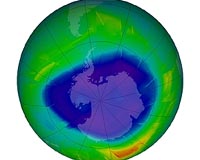| . |  |
. |
West Lafayette IN (SPX) Dec 08, 2009 There is more to the snowflake than its ability to delight schoolchildren and snarl traffic. The structure of the frosty flakes also fascinate ice chemists like Purdue University's Travis Knepp, a doctoral candidate in analytical chemistry who studies the basics of snowflake structure to gain more insight into the dynamics of ground-level, or "tropospheric," ozone depletion in the Arctic. "A lot of chemistry occurs on ice surfaces," Knepp said. "By better understanding the physical structure of the snow crystal - how it grows and why it takes a certain shape - we can get a better idea of the chemistry that occurs on that surface." His work on snowflake shape and how temperature and humidity affect it takes place in a special laboratory chamber no larger than a small refrigerator. Knepp can "grow" snow crystals year-round on a string inside this chamber. The chamber's temperature ranges from 100-110 degrees Fahrenheit down to minus 50 degrees Fahrenheit. Knepp, under the direction of Paul Shepson, professor and head of Purdue's Department of Chemistry, is studying snow crystals and why sharp transitions in shape occur at different temperatures. The differences he sees not only explain why no two snowflakes are identical, but also hold implications for his ozone research in the Arctic Ocean region. "On the surface of all ice is a very thin layer of liquid water," Knepp said. "Even if you're well below the freezing point of water, you'll have this very thin layer of water that exists as a liquid form. That's why ice is slippery. Whenever you slip, you're not slipping on ice, you're slipping on that thin layer of water." This thin, or quasi-liquid, layer of water exists on the top and sides of a snow crystal. Its presence causes the crystal to take on different forms as temperature and humidity change. For example, the sides of a crystal growing in a warmer range of 27-32 degrees Fahrenheit expand much faster than the top or bottom, causing it to take on a platelike structure. Between 14 and 27 degrees Fahrenheit, crystals look like tall, solid prisms or needles. "As you increase the humidity, you'll get more branching," Knepp said. Snow crystals transition to other shapes, and sometimes even back and forth, as the temperature and humidity change. "The bottom line is that the thickness or the presence of this really thin layer of water is what dictates the general shape that the snow crystal takes," Knepp said. "By altering the quasi-liquid layer's thickness, we changed the temperature at which the snow crystal changes shape. "Until now, nobody knew that the quasi-liquid layer had such a significant role in determining the shape of snow crystals. Our research clearly shows this to be the case." This knowledge has application for Knepp and his colleagues in their ozone work. "Most people have probably heard of ozone depletion in the North and South Poles. This occurs in the stratosphere, about 15 miles up," Knepp said. "What people don't know is that we also see ozone levels decrease significantly at ground level." Ground-level ozone is very important. It gives the atmosphere the ability to clean itself. However, it also is toxic to humans and vegetation at high concentrations, like those found in smog, Shepson said. Complex chemical reactions regularly take place on the snow's surface. These reactions, which involve the thin layer of water found on the surface of snow crystals, cause the release of certain chemicals that reduce ozone at ground level. "How fast these reactions occur is partially limited by the snow crystals' surface area," Knepp said. "Snow crystals with more branching will have higher surface areas than non-branched snow crystals, which will allow the rate of reaction to increase." The need to understand these intricate chemical reactions and their implications for ozone reduction drive the researchers to continue studying snow. "As the impact of emissions from human activities continues to grow, we need to be able to understand the impact of global average ozone," Shepson said. "Understanding ice and snow is part of that." Share This Article With Planet Earth
Related Links Purdue University All about the Ozone Layer
 Ozone Layer Depletion Levelling Off
Ozone Layer Depletion Levelling OffParis, France (ESA) Sep 22, 2009 By merging more than a decade of atmospheric data from European satellites, scientists have compiled a homogeneous long-term ozone record that allows them to monitor total ozone trends on a global scale - and the findings look promising. Scientists merged monthly total ozone data derived from the vertically downward-looking measurements of the GOME instrument on ESA's ERS-2 satellite ... read more |
|
| The content herein, unless otherwise known to be public domain, are Copyright 1995-2009 - SpaceDaily. AFP and UPI Wire Stories are copyright Agence France-Presse and United Press International. ESA Portal Reports are copyright European Space Agency. All NASA sourced material is public domain. Additional copyrights may apply in whole or part to other bona fide parties. Advertising does not imply endorsement,agreement or approval of any opinions, statements or information provided by SpaceDaily on any Web page published or hosted by SpaceDaily. Privacy Statement |